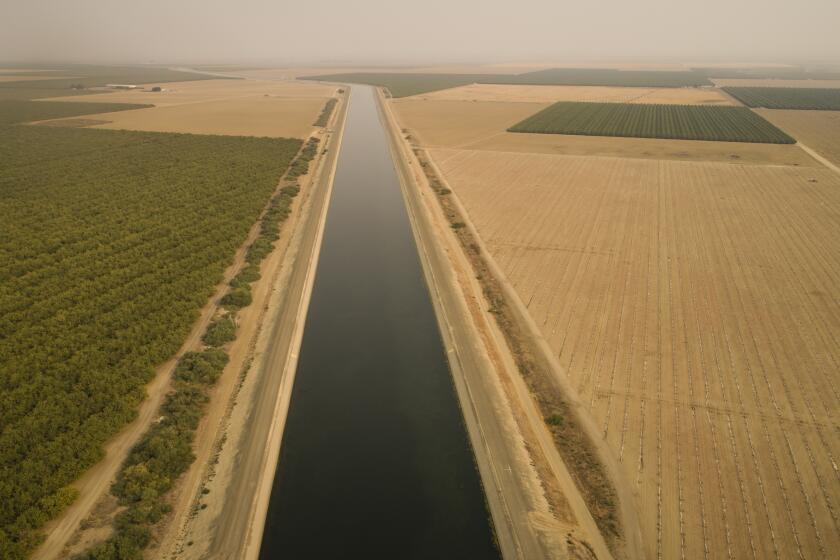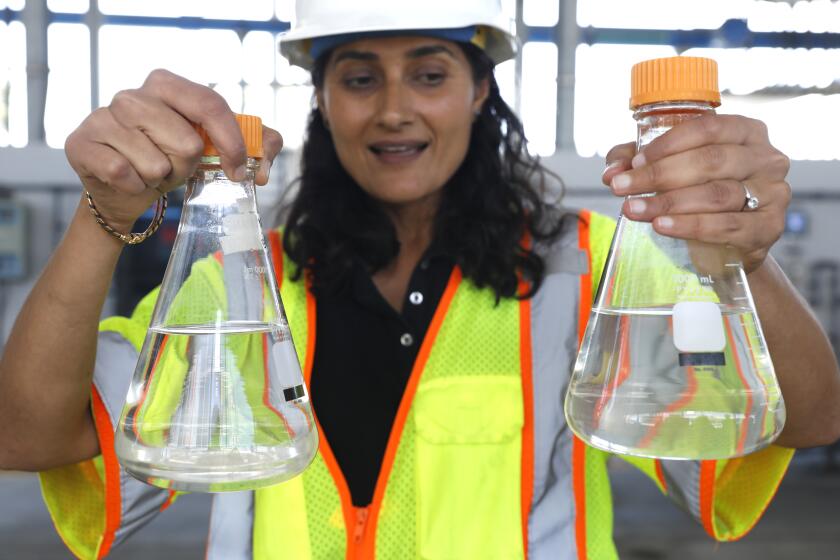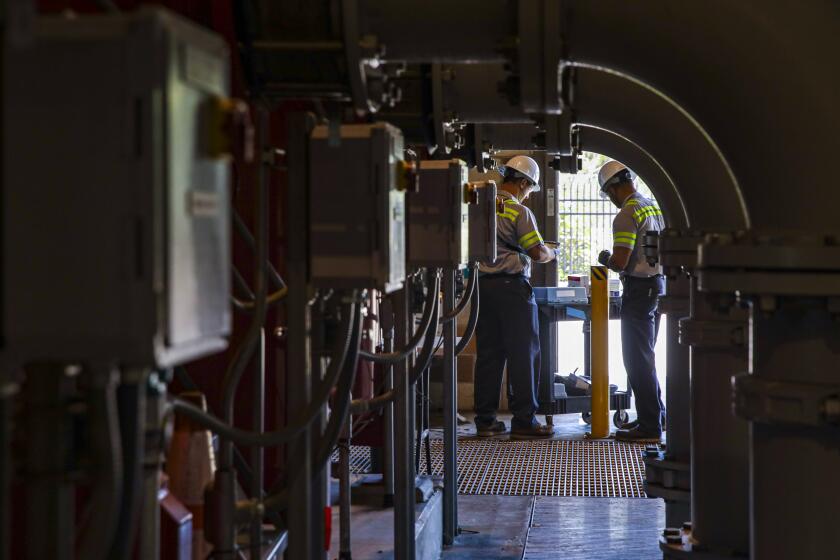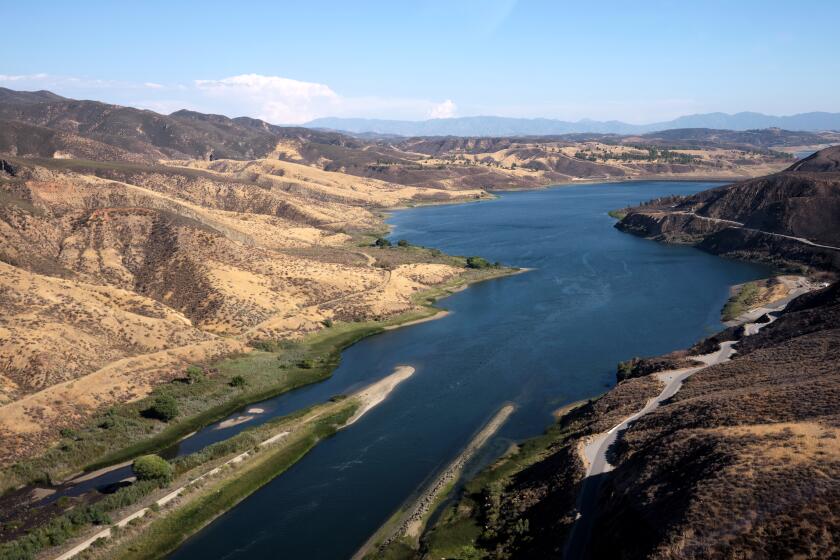Drought-ravaged L.A. seeks surprising source of water: A contaminated Superfund site

- Share via
As drought and climate change ravage California’s once-reliable supply of drinking water, officials in Los Angeles are setting their sights on a relatively new, almost untapped resource for the city’s 4 million residents: the Superfund site in their own backyard.
Nearly 70% of the city’s 115 wells in the San Fernando Valley groundwater basin — the largest such basin under the purview of the Los Angeles Department of Water and Power — have been sitting unused for decades after dangerous contaminants seeped into the aquifer.
Now, the city is nearing the completion of a massive, $600-million plan to bring that resource back online. Centered on three treatment facilities in the Valley, the groundwater remediation project will essentially create giant filters for the city’s toxic plume, enabling Angelenos to regain full access to up to 87,000 acre-feet of water each year, or nearly a fifth of what they consume.
Some say it can’t happen soon enough.
“What the drought does is it makes groundwater even more important as a source of water for us — that’s really what it comes down to,” said Anselmo Collins, senior assistant general manager at the DWP. “The ultimate goal is to be able to take this water and be able to put it into the drinking water system.”
The Department of Water Resources announced an initial allocation of just 5% of requested supplies from the State Water Project.
The project has been years in the making, but the problem can be traced back even further.
In the mid-20th century, a postwar boom transformed the San Fernando Valley into a fertile home for commerce and manufacturing, including major players in the aerospace, automobile and defense industries. But as those companies began storing and disposing of metals, solvents and other waste in the area, known carcinogens such as trichloroethylene, perchloroethylene, hexavalent chromium and 1,4-dioxane trickled into the Valley’s aquifer.
The extent of the problem wasn’t fully uncovered until after the Safe Drinking Water Act of 1974 mandated increased testing and monitoring standards for drinking water, according to Larry Sievers, the site’s remedial project manager for the Environmental Protection Agency. By then, the basin was so contaminated it earned the agency’s dreaded Superfund designation, indicating a site so polluted as to require a long-term cleanup response.
“Superfund sites are kind of the worst of the worst,” Sievers said. “Now and then we get a site like San Fernando Valley that is just tremendous in scope.”

Indeed, the massive basin sits beneath several communities, including large swaths of Los Angeles, Burbank and Glendale. More than a dozen organizations have a stake in its remediation, Sievers said.
But the largest share of water rights in the basin belongs to the DWP, which spent years searching for responsible parties to take ownership over the pollution, to little avail.
“The challenge that we have with the San Fernando basin is that it is the largest basin — the one that we have the most entitlements to — but also the one that is contaminated,” Collins said.
The city has long relied on other supplies to get by, including water imported from the Owens Valley, Northern California and the Colorado River via a network of aging aqueducts. But as drought saps those sources, Los Angeles is being forced to fundamentally overhaul its water infrastructure.
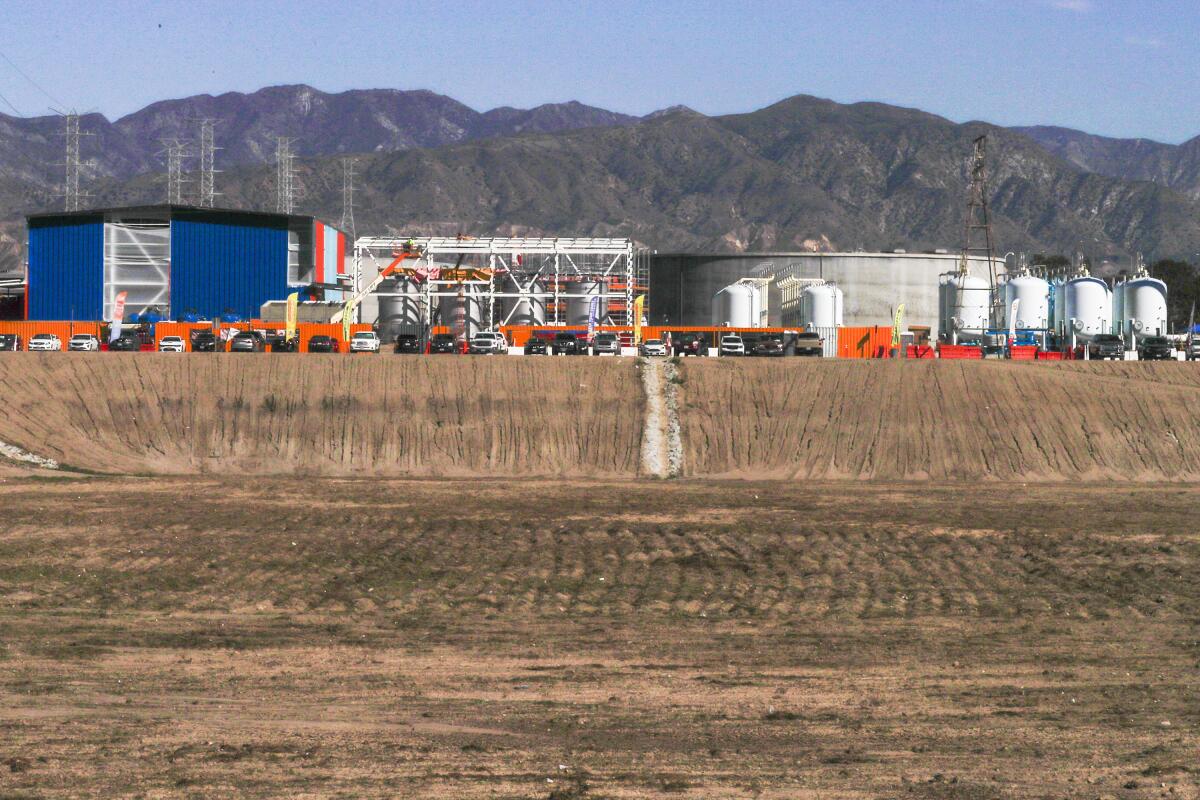
Currently, only 10% of the water used by the city is sourced locally. The DWP hopes that will increase to 70% by 2035 as the filtration equipment and other major projects are completed.
“Not only does it make us more drought-proof if you have the water, especially in the groundwater basin, but also a little more earthquake proof,” Collins said. “Because it’s not a matter of if, it’s a matter of when we’re going to have a quake, and the aqueducts cross the San Andreas fault.”
In the face of dire drought, cities and water agencies are now investing heavily in large-scale wastewater recycling facilities.
Mark Gold, a Los Angeles water expert and adjunct professor at UCLA’s Institute of the Environment and Sustainability, said it pained him to think of such a valuable resource being underutilized for the better part of four decades.
“The only people who were getting paid were the lawyers and the people doing the groundwater studies, but at the end of the day the public was not getting their supply,” Gold said. He noted that shrinking state and federal supplies and the rising cost of water have made it more urgent than ever to bring the basin back into the mix.
“To say that we should be able to get to a quarter of our water supply from groundwater in the city of Los Angeles is not a stretch at all,” he said. “Sustainable local water is where we need to go … and the groundwater is a huge part of it.”
In fact, the restoration of the San Fernando Valley groundwater basin is a considerable piece of L.A.’s plan for the future, which includes big investments in water recycling and storm-water capture as well as a persistent push for conservation, all in the name of reducing reliance on imported supplies.
But cleaning decades-old contaminants from a major municipal water source is a massive undertaking. The multi-step process will include pumping the water out of the ground and then running it through a series of filters and treatments, according to Evelyn Cortez-Davis, director of water engineering and technical services at the DWP.
She walked through the steps during a recent tour of the Tujunga Spreading Grounds facility in Sun Valley, which will house the largest of the three project sites upon its completion in 2023.
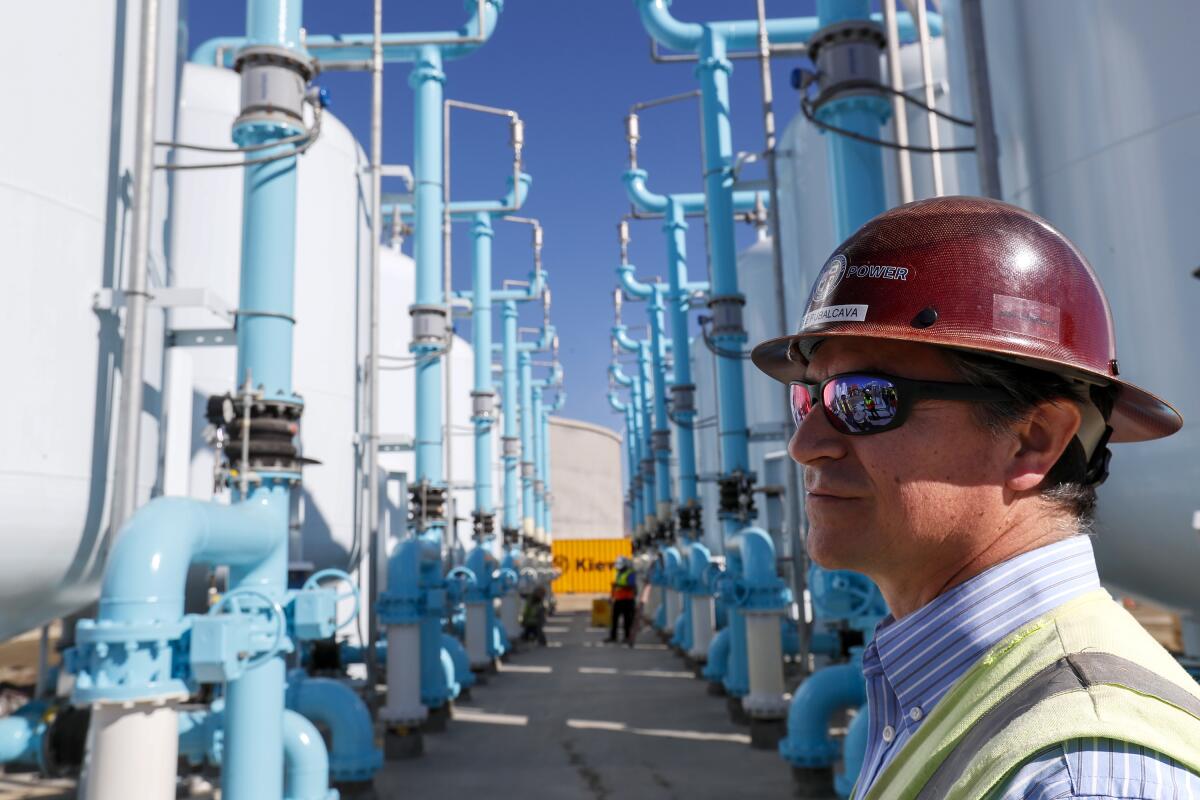
First, the pumped water will be cleaned with hydrogen peroxide, then pushed through filters to remove sediment such as dirt and sand, Cortez-Davis said. Next, the water will be bombarded by hundreds of ultraviolet lamps for disinfection. Finally, it will be run through huge tanks of granular activated carbon, which will adsorb any residual hydrogen peroxide and remove other harmful compounds.
Only then will it be ready for the standard treatment that all L.A. tap water receives, including doses of chlorine, ammonia and other additives. The treated water will meet all federal and state standards for drinking water, Cortez-Davis said.
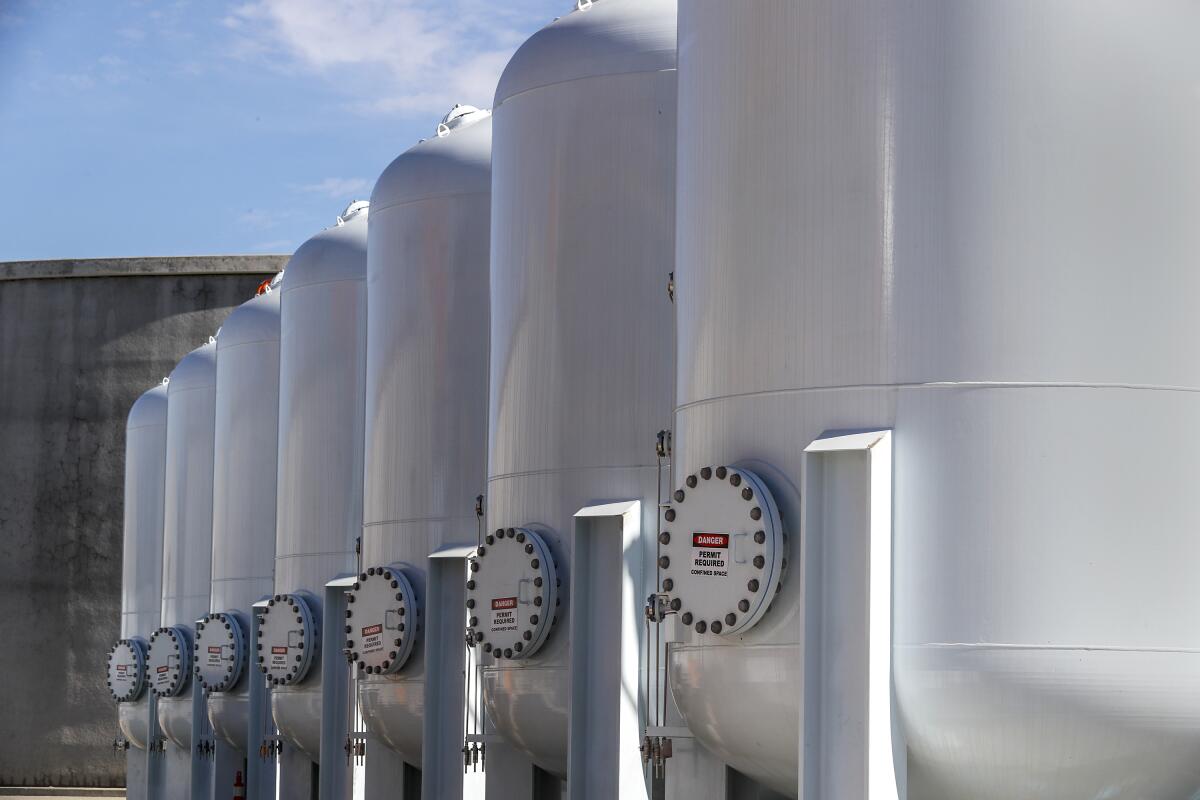
She noted that because of the way the city is plumbed, the water won’t stay in the San Fernando Valley but instead “gets integrated into the entire distribution system,” benefiting almost all of Los Angeles.
“The focus of the city has been on conservation for so long that we do it really, really well,” Cortez-Davis said as she walked through the construction site. “The part that I think is lost on people, sometimes, is how much we rely on groundwater during dry periods, and the fact that we had so many of our wells impacted for so long.”
Los Angeles is considering ‘direct potable reuse,’ which means putting purified recycled water directly back into drinking water systems.
But part of the reason the site sat unused for so long is because officials spent years tied up in litigation and working to find responsible parties who could help pay for cleanup costs.
Some big name companies, including Honeywell and Lockheed Martin, have already agree to take ownership over some of the decades-old chemicals and committed to funding cleanup efforts or making up the losses in kind, according to the DWP. Others have yet to be identified, and some may no longer exist all these years later.
“The onus is on us, then, as the steward of our groundwater basin, to make sure that we continue to have access to this groundwater, because it is a critical supply,” Cortez-Davis said. Rather than wait for a resolution, “the alternative was for the ratepayers of L.A. to proactively do it and regain our resource.”
That means Angelenos are shouldering some of the cleanup costs, she said, though the EPA and the cities of Burbank and Glendale are also treating water in other parts of the basin.
“It’s delicate, and we all rely on it,” said Richard Wilson, assistant general manager of Burbank Water and Power. “We need to be good stewards of the water that we import, the water that we have in the ground, and it’s a regional issue, especially with the drought.”
L.A. has invested significantly in its water future, but many projects remain unfinished. We asked Karen Bass and Rick Caruso their plans.
In Los Angeles, nearly half of the project money so far — about $310 million of $634 million — has come from state grant funds through Proposition 1, a $7.5-billion water bond passed by voters in 2014.
Joe Karkoski, deputy director of the division of financial assistance with the State Water Resources Control Board, which administers the funds, said it was precisely the kind of project the bond was created for.
“As they’re able to clean up the groundwater contamination, they’re putting more of their municipal wells that had to be put inactive back online,” he said. “That means their portfolio starts changing over time — they become less reliant on surface water ... and more reliant on local groundwater resources.”
There are other projects in the works as well, including the dual use of the Tujunga site as an improved spreading grounds facility to capture more storm water when it rains. With some treatment capabilities already up and running, the city has doubled Tujunga’s ability to capture storm water from 8,000 acre-feet per year to 16,000, or roughly 5 billion gallons, officials said.
Gold, of UCLA, said the scope and scale of the projects in the San Fernando Valley give him “a tremendous amount of hope” for the city’s water future.”
“We’re getting reliable, local water supplies,” he said, “and that’s something we need a lot more of here in the state of California.”
More to Read
Sign up for Essential California
The most important California stories and recommendations in your inbox every morning.
You may occasionally receive promotional content from the Los Angeles Times.
